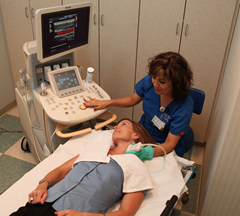- Cardiology And Vascular Health
- Health Topics
- Heart And Vascular Disease Prevention
- Stroke
- Stroke And Other Vascular Diseases
Go For The Flow To Prevent Clogged Neck Arteries And Stroke

Find Your Perfect Match
Answer a few questions and we'll provide you with a list of primary care providers that best fit your needs.
Vital blood and oxygen gets to your brain, your head, and your face through vascular channels on both sides of your neck called carotid arteries. If plaque builds up in these arteries and narrows or blocks the flow of blood, you can have a stroke. That’s the bad news. The good news is you can take steps to keep your arteries open and flowing.
Stroke occurs when a blood clot forms in the artery or when a piece of plaque breaks off and blocks blood flow. Either way, your brain and head don’t get the oxygen they need to function normally.
Carotid artery narrowing – or stenosis – is a major cause of stroke in the U.S. “In the last 10 years, death from stroke has dropped to the fifth leading cause of death for Americans, but it’s still the leading cause of disability,” says vascular neurologist Esteban Cheng-Ching, MD.
Are you at risk? You are if there’s a family history of carotid artery disease. You’re at greater risk if you have high blood pressure, high cholesterol, or diabetes. Smoking, obesity, physical inactivity, and being over age 50 also raise your likelihood.
So there is no time like right now, says Dr. Ching, to make lifestyle choices that significantly reduce your risk of having a dangerous buildup of cholesterol and plaque in those very important carotid arteries.
Preventing Carotid Artery Stenosis
What’s good for the heart is good for the carotid arteries. Dr. Ching offers these guidelines to keep your carotid arteries healthy:
- Control high blood pressure. “Hypertension is the most important risk factor for stroke, because it causes long-term damage to blood vessels that causes them to create plaque or shut down,” Dr. Ching says.
- Control high cholesterol by eating a heart-healthy diet or taking cholesterol-lowering medications prescribed by your doctor.
- Don’t smoke.
- Be physically active. Doctors recommend a minimum of 150 minutes of moderate activity a week.
- Maintain a healthy weight.
“Prevention is the best method to treat stroke,” Dr. Ching says.
What’s good for the heart is good for the carotid arteries.
Diagnosis And Treatment For Carotid Artery Disease
Often, a stroke is the first symptom your carotid arteries have a problem.
“If you fall into a high-risk group for carotid artery stenosis, we can examine you during a yearly checkup to listen for a swishing sound that could indicate a narrowing of the arteries. We closely monitor patients with greater than 50 percent stenosis,” Dr. Ching notes.
Other screening tools include carotid ultrasound using sound waves to study the arteries. If your doctor finds a blockage, imaging tests, including MRI, CT angiography, and cerebral angiogram, can help determine the location and extent of blockage.
If you are diagnosed with carotid artery stenosis, first-line treatment is antiplatelet medications to thin the blood and prevent blood clots. Your doctor will also treat risk factors such as high blood pressure, high cholesterol, and diabetes. And if you smoke, you should stop.
“Certain patients may need an endovascular procedure or surgical procedure to open up the artery,” he continues.
Carotid angioplasty and stenting widens a carotid artery and restores blood flow. Your doctor inserts a thin tube with a balloon on the end. Once in place in the carotid artery narrowing, the balloon inflates to push plaque back against the artery wall and create a larger opening for blood flow. A small mesh tube called a stent may be used to maintain the opening.
Carotid endarterectomy is a surgical procedure for carotid arteries with 50 percent or more blockage. Your surgeon cuts into the artery and removes the plaque that is creating the blockage.
“With each procedure, we evaluate the risks and benefits,” Dr. Ching says. “At an experienced medical center, there’s a less than 3 percent complication rate.”
BE FAST

Often, your first warning sign of carotid artery stenosis is a transient ischemic attack (also called a TIA or mini-stroke) or a stroke. TIA symptoms generally stop within an hour, but a stroke can have much more devastating effects. Even if the symptoms resolve, you should seek medical attention immediately to prevent recurrence or progression.
Quick action is essential to minimize damage to your brain.
A good way to remember signs of stroke is to think BE FAST:
Balance or coordination problems
Eyes: Suddenly blurred or double vision or sudden loss of vision
Face drooping on one side
Arm weakness on one side
Speech
altered
Time to call 911
Find Your Perfect Match
Answer a few questions and we'll provide you with a list of primary care providers that best fit your needs.
Source: Esteban Cheng-Ching, MD; Clinical Neuroscience Institute; National Heart, Lung and Blood Institute; Radiologyinfo.org





